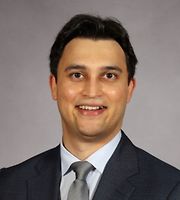Central Auckland > Public Hospital Services > Te Whatu Ora – Health New Zealand Te Toka Tumai Auckland >
Neurosurgery | Auckland | Te Toka Tumai | Te Whatu Ora
Public Service, Neurosurgery
Description
Consultants
-

Mr Robert Aspoas
Neurosurgeon
-

Mr Lawrence (Siu) Choi
Neurosurgeon
-

Mr Jason Correia
Neurosurgeon
-

Mr Peter Heppner
Neurosurgeon
-

Dr Chien Kow
Neurosurgeon
-

Mr Andrew Law
Neurosurgeon - Service Clinical Director
-

Ms Phoebe Matthews
Neurosurgeon
-

Mr Patrick Schweder
Neurosurgeon
Referral Expectations
Referrals are triaged (sorted into groups according to urgency of need) by specialists and allocated a grading. If serious, i.e Grade 1, the case is booked immediately for Outpatients.
Urgent cases go through the Emergency Department via the on call registrar.
Procedures / Treatments
A cerebral (cranial) aneurysm is a weakened section in the wall of a blood vessel in the brain that bulges or balloons out. Possible causes of cerebral aneurysm include: a defect in the blood vessels present at birth, brain tumour, head trauma or atherosclerosis (fatty deposits start to block the arteries). A small aneurysm may produce no symptoms but as it grows it might cause vision problems, facial numbness or seizures. A ruptured or burst aneurysm can cause bleeding in and around the brain which may affect mental skills and bodily functions and may, in serious cases, lead to brain damage, stroke, coma or death. Surgical Clipping This is a treatment that can be used for both unruptured and ruptured aneurysms. The skull is opened surgically (craniotomy) and the aneurysm is isolated from the rest of the blood vessel using a small metal clip that seals off each end of the aneurysm. Endovascular Clipping This is a less invasive form of treatment that avoids the need for surgery. A catheter (a small, flexible tube) is inserted into an artery in the groin and gently pushed up to the brain. At the site of the aneurysm, the catheter releases soft wire coils that block the aneurysm from inside the blood vessel. Sometimes a tiny balloon is also released to help hold the coils in place.
A cerebral (cranial) aneurysm is a weakened section in the wall of a blood vessel in the brain that bulges or balloons out. Possible causes of cerebral aneurysm include: a defect in the blood vessels present at birth, brain tumour, head trauma or atherosclerosis (fatty deposits start to block the arteries). A small aneurysm may produce no symptoms but as it grows it might cause vision problems, facial numbness or seizures. A ruptured or burst aneurysm can cause bleeding in and around the brain which may affect mental skills and bodily functions and may, in serious cases, lead to brain damage, stroke, coma or death. Surgical Clipping This is a treatment that can be used for both unruptured and ruptured aneurysms. The skull is opened surgically (craniotomy) and the aneurysm is isolated from the rest of the blood vessel using a small metal clip that seals off each end of the aneurysm. Endovascular Clipping This is a less invasive form of treatment that avoids the need for surgery. A catheter (a small, flexible tube) is inserted into an artery in the groin and gently pushed up to the brain. At the site of the aneurysm, the catheter releases soft wire coils that block the aneurysm from inside the blood vessel. Sometimes a tiny balloon is also released to help hold the coils in place.
Brain tumours may be primary (they arise in the brain or nearby tissue) or metastatic (they have originated in another part of the body and travelled to the brain, usually via the bloodstream). Primary tumours may either be benign (they do not spread to other tissues) or malignant (they spread). Surgery may be the only treatment approach for a brain tumour, or it may be used in combination with radiation therapy and/or chemotherapy. Typically, the skull is opened up (craniotomy) giving the surgeon access to the tumour and allowing removal of as much of the tumour as possible without damaging brain tissue. A stereotactic biopsy is another surgical procedure often performed to aid in tumour diagnosis. A small hole is drilled into the skull and a sample of tissue removed for examination under the microscope. Radiation therapy uses high energy x-rays to kill abnormal cells, while chemotherapy uses chemicals to destroy cancer cells.
Brain tumours may be primary (they arise in the brain or nearby tissue) or metastatic (they have originated in another part of the body and travelled to the brain, usually via the bloodstream). Primary tumours may either be benign (they do not spread to other tissues) or malignant (they spread). Surgery may be the only treatment approach for a brain tumour, or it may be used in combination with radiation therapy and/or chemotherapy. Typically, the skull is opened up (craniotomy) giving the surgeon access to the tumour and allowing removal of as much of the tumour as possible without damaging brain tissue. A stereotactic biopsy is another surgical procedure often performed to aid in tumour diagnosis. A small hole is drilled into the skull and a sample of tissue removed for examination under the microscope. Radiation therapy uses high energy x-rays to kill abnormal cells, while chemotherapy uses chemicals to destroy cancer cells.
A subdural haematoma is a collection of blood that forms beneath the outer protective covering of the brain, the dura mater. It is usually caused by tiny blood vessels becoming torn as the result of serious head trauma such as a fall, blow to the head or car accident. Symptoms include: · Headache · Speech problems · Vision problems · Seizures · Confusion · Weakness · Nausea and vomiting With an acute haematoma, symptoms appear within 24 hours of the trauma while in the case of subacute or chronic haematomas symptoms take longer to appear. If a haematoma is left to grow, it puts pressure on the brain which may lead to brain damage and possibly death. Surgical treatment involves drilling a small hole in the skull, allowing the haematoma to drain and thus relieving the pressure on the brain. In the case of a larger haematoma, a hole may be cut in the skull (craniotomy) allowing the surgeon access to the brain to repair damaged vessels and remove the blood clot.
A subdural haematoma is a collection of blood that forms beneath the outer protective covering of the brain, the dura mater. It is usually caused by tiny blood vessels becoming torn as the result of serious head trauma such as a fall, blow to the head or car accident. Symptoms include: · Headache · Speech problems · Vision problems · Seizures · Confusion · Weakness · Nausea and vomiting With an acute haematoma, symptoms appear within 24 hours of the trauma while in the case of subacute or chronic haematomas symptoms take longer to appear. If a haematoma is left to grow, it puts pressure on the brain which may lead to brain damage and possibly death. Surgical treatment involves drilling a small hole in the skull, allowing the haematoma to drain and thus relieving the pressure on the brain. In the case of a larger haematoma, a hole may be cut in the skull (craniotomy) allowing the surgeon access to the brain to repair damaged vessels and remove the blood clot.
Tumours may be found within the spinal cord itself, between the spinal cord and its tough outer covering, the dura, or outside the dura. They may be primary (they arise in the spine or nearby tissue) or metastatic (they have originated in another part of the body and travelled to the spine, usually via the bloodstream). Spinal tumours may be treated by any combination of surgery, radiotherapy and chemotherapy. Surgery may be performed to take a small sample of tissue to examine under the microscope (biopsy) or to remove the tumour. Typically, the patient will be lying face downwards and a procedure known as a laminectomy is performed (the bone overlying the spinal cord is removed). This gives the surgeon access to the spinal cord and allows removal of the tumour.
Tumours may be found within the spinal cord itself, between the spinal cord and its tough outer covering, the dura, or outside the dura. They may be primary (they arise in the spine or nearby tissue) or metastatic (they have originated in another part of the body and travelled to the spine, usually via the bloodstream). Spinal tumours may be treated by any combination of surgery, radiotherapy and chemotherapy. Surgery may be performed to take a small sample of tissue to examine under the microscope (biopsy) or to remove the tumour. Typically, the patient will be lying face downwards and a procedure known as a laminectomy is performed (the bone overlying the spinal cord is removed). This gives the surgeon access to the spinal cord and allows removal of the tumour.
Between the vertebrae in your spine are flat, round discs that act as shock absorbers for the spinal bones. Sometimes some of the gel-like substance in the center of the disc (nucleus) bulges out through the tough outer ring (annulus) and into the spinal canal. This is known as a herniated or ruptured disc and the pressure it puts on the spinal nerves often causes symptoms such as pain, numbness and tingling. Initial treatment for a herniated disc may involve low level activity, nonsteroidal anti-inflammatory medication and physiotherapy. If these approaches fail to reduce or remove the pain, surgical treatment may be considered. Discectomy This surgery is performed to remove part or all of a herniated intervertebral disc. Open discectomy – involves making an incision (cut) over the vertebra and stripping back the muscles to expose the herniated disc. The entire disc, or parts of it are removed, thus relieving pressure on the spinal nerves. Microdiscectomy – this is a ‘minimally invasive’ surgical technique, meaning it requires smaller incisions and no muscle stripping is required. Tiny, specialised instruments are used to remove the disc or disc fragments. Laminectomy or Laminotomy These procedures involve making an incision down the centre of the back and removing some or all of the bony arch (lamina) of a vertebra. In a laminectomy, all or most of the lamina is surgically removed while a laminotomy involves partial removal of the lamina. By making more room in the spinal canal, these procedures reduce pressure on the spinal nerves. They also give the surgeon better access to the disc and other parts of the spine if further procedures e.g. discectomy, spinal fusion, are required. Spinal Fusion In this procedure, individual vertebrae are fused together so that no movement can occur between the vertebrae and hence pain is reduced. Spinal fusion may be required for disc herniation in the cervical region of the spine as well as for some cases of vertebral fracture and to prevent pain-inducing movements.
Between the vertebrae in your spine are flat, round discs that act as shock absorbers for the spinal bones. Sometimes some of the gel-like substance in the center of the disc (nucleus) bulges out through the tough outer ring (annulus) and into the spinal canal. This is known as a herniated or ruptured disc and the pressure it puts on the spinal nerves often causes symptoms such as pain, numbness and tingling. Initial treatment for a herniated disc may involve low level activity, nonsteroidal anti-inflammatory medication and physiotherapy. If these approaches fail to reduce or remove the pain, surgical treatment may be considered. Discectomy This surgery is performed to remove part or all of a herniated intervertebral disc. Open discectomy – involves making an incision (cut) over the vertebra and stripping back the muscles to expose the herniated disc. The entire disc, or parts of it are removed, thus relieving pressure on the spinal nerves. Microdiscectomy – this is a ‘minimally invasive’ surgical technique, meaning it requires smaller incisions and no muscle stripping is required. Tiny, specialised instruments are used to remove the disc or disc fragments. Laminectomy or Laminotomy These procedures involve making an incision down the centre of the back and removing some or all of the bony arch (lamina) of a vertebra. In a laminectomy, all or most of the lamina is surgically removed while a laminotomy involves partial removal of the lamina. By making more room in the spinal canal, these procedures reduce pressure on the spinal nerves. They also give the surgeon better access to the disc and other parts of the spine if further procedures e.g. discectomy, spinal fusion, are required. Spinal Fusion In this procedure, individual vertebrae are fused together so that no movement can occur between the vertebrae and hence pain is reduced. Spinal fusion may be required for disc herniation in the cervical region of the spine as well as for some cases of vertebral fracture and to prevent pain-inducing movements.
Website
Contact Details
Auckland City Hospital
Central Auckland
Website
Accepted patients' outpatient booking enquiries can be made directly to the Neurosurgery secretary on (09) 307 4949 ext 25770.
2 Park Road
Grafton
Auckland 1023
Street Address
2 Park Road
Grafton
Auckland 1023
Postal Address
Private Bag 92 024
Auckland Mail Centre
Auckland 1142
Was this page helpful?
This page was last updated at 9:48AM on May 18, 2023. This information is reviewed and edited by Neurosurgery | Auckland | Te Toka Tumai | Te Whatu Ora.

